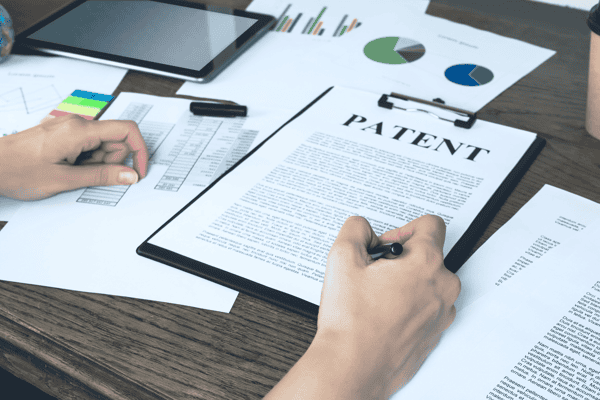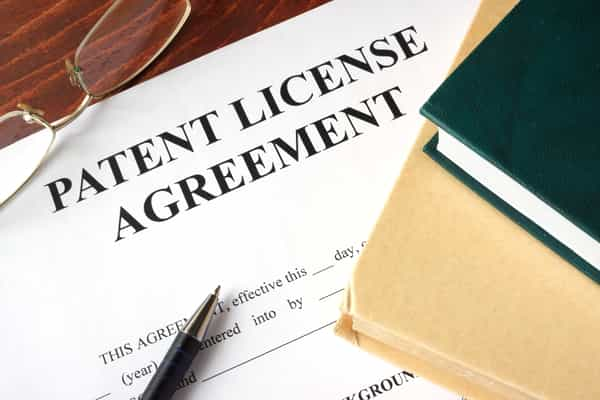Learn how and when to file a patent application, and how to avoid common errors.
For life science or medical technology companies, patents are the most important form of intellectual property (IP). Small businesses rely on patents to maintain the value and lucrativeness of their business. A patent on your design/product will keep people from copying your reinvention, thereby making your company the most sought after for that particular invention. Registering the company name and maintaining secrets are second tier IP for these types of companies behind patents.
🔬 Related: Intellectual Property for Life Science Companies
A patent is a government-granted right to exclude others from making, using, offering for sale, selling, or importing into the United States the invention being patented. The most important part of that description is the right to “exclude others''. This means that you can prevent other people from doing what your patent outlines. It does not, however, give you the right to carry out the patent or sell the product/design in the US. For example, you might need FDA clearance before you can market your product in the US.
Part of each patent is the issued claims section. Only the issued claims outlined within the patent have enforceable rights. If a detail is left out or is too ambiguous, it might not qualify for excludability.
Patents typically have a 20 year term from the earliest filing. Another important piece of information is that patents are issued by individual countries only, and therefore only have national effect.

There are multiple forms of intellectual property, mainly:
A company that maintains a rigorous patent strategy will also be enabled to maintain its business goals. There are three main advantages to filing a patent:
Protect your product or service
Conduct patent landscape research to protect your company
Help secure financing and enable an exit strategy
Before you outline your claims in a patent, you must disclose your invention and how it works. This allows the world to see how to use and make the invention. Within this disclosure there are 2 main things needed: novelty and non-obviousness. Novel means new, meaning your invention needs to not have been patented prior. Non-obvious is a function of time, meaning that the more time goes on, the higher probability that colleagues in your field would determine your invention obvious.
Subject matter eligibility is less important, as it is possible to patent almost anything. In recent years we have seen this with new patents for software, apps, compounds, etc. Your patent doesn’t need to be restricted to a physical product!
🔬 Read about: A Startup's Guide to Copyrighting, Trademarking, and Patenting
Several US laws govern the disclosure of patents. They all culminate into one main idea.
"Your patent must describe your invention with enough detail so that one of skill in the art can practice the invention."
Take heed to the fact that "one of skill in the art" needs to be able to replicate the patent. You do not need to teach someone new how to do it, but the disclosure must be relatively easy to follow.
The best way to think of disclosure is to describe both the structure and the function of the invention.
The structure is perhaps the most important part of the disclosure. You want to answer a few key questions in your description. What is it made of? How big is it? How can it be rebuilt? Etc.
Structure can mean different things for different inventions. The patent for a microscope will be much different than one for a computer software. Here are a few things to think of including in order to describe the structure of your invention:
Another thing to keep in mind when describing structure is limitations. When constructing your application, you do not want to limit your invention to simply what is in photos, or the "one sentence" description. Including other possible embodiments of your invention can increase the scope of your patent. This is where a patent lawyer might come in handy; they can help draft applications that let you get the most out of your patent.
The key to showing function is showing data. The type of data, whether in-vitro or in-vivo, will depend on the type of invention and prior art. Including data will demonstrate that your invention actually works.
The amount of data will depend on the prior art in your field. The more prior art there is, the more data/disclosure you will need in order to prove that your invention has not been created before. If your invention is completely unprecedented, you might not need any data, but this case is very rare. Conversely, if your invention is entering a crowded field, you might need more data to prove that your invention is unique and/or better.
Another important note is that your data could be prophetic, meaning you have not practiced the experiments yet. You just need to describe them, with a plan to carry them out in the future. However, having real time data is helpful for patents in a crowded field, and removes the need for a supplementary application.

Prior art is a term for the previous work of others. There are two main parts of prior art:
Anticipatory means that a single prior work anticipates every aspect of your invention. Obviousness means that a combination of works have rendered your invention obvious. If these two ideas seem to overlap a little bit, it is because they do! The main takeaway that this article will try to prevent is becoming your own worst enemy. That is, creating barriers for yourself trying to patent something in the future or a similar nature.
🔬Related Article: How Do Other's Patents Affect You?
The most common anticipatory references are the inventors’ own work. This is because inventors typically work in the same field for years and years, meaning each new invention could be very similar to the last. The best thing to do to prevent this is to file your (provisional) patent application before any disclosure of your invention, even a confidential disclosure. Filing your patent first will prevent your own works (like speeches, journal articles, etc) from being used against you in the patent approval process.
In order to avoid becoming your own worst enemy in future patent applications, you should try to avoid:
However, some of these things are easier said than done to avoid. These might be vital parts of your business, like getting the word out or talking to investors. When in doubt, you should discuss future publications or disclosures with your patent attorney. They will be able to advise you on how to avoid being your own worst enemy in future patent applications.
Timing your first and subsequent patent applications is important to creating a well rounded portfolio. The main thing to remember is that an early priority date will mean less prior art, and less chance of obviousness. You can secure a priority date without creating an entire patent application by filing a provisional application. Provisional applications secure priority dates for what is disclosed within the filing, not what is disclosed in the full patent application.
Filing multiple patents is the key to extending your patent protection beyond the normal 20 years. The best way to do this is to file a second provisional application just prior to the publication of the first patent. Typically, patents take 18 months to be published by the USPTO. The day before that publishing, a provisional application can be filed for the next generation of the invention in order to secure the priority date. Submitting the applications back to back will prevent you from becoming your own worst enemy by publishing something that wasn’t covered in an existing patent application.
The next step is choosing what foreign countries you might want to file in as well. This part is the most expensive and intricate, so you will definitely need the advice of an experienced patent attorney. The good news is, you can wait up to 30 months from the first provisional application until you file in a foreign country for the same invention.
Filing a patent application can be a complicated and confusing process. The most important things to remember are maintaining novelty and non-obviousness. In order to remain non-obvious, filing as soon as possible is always best. This is in order to limit the amount of prior art that could be used against your patent, including your own. Consulting with a patent attorney is a great way to set up a plan to maximize your patent protection and longevity.
*This article is an educational and informational presentation of general IP law and should not be construed as individualized legal advice or representation. Consult with legal counsel before implementing these strategies.
This content comes from a University Lab Partners webinar hosted in partnership with Wilson Sonsini presented by Maysam Pessian. Watch the full video here.
Maysam Pessian is an associate in the San Diego office of Wilson Sonsini Goodrich & Rosati. His practice focuses on patent prosecution and intellectual property counseling, serving clients in a wide range of technology fields, including the pharmaceuticals and biotechnology industries.
Be sure to subscribe to the ULP Youtube Channel to never miss another webinar, and connect with us on LinkedIn to stay in the loop!
Download The Ultimate Guide to Wet Lab Incubators in Southern California, a handbook to assist life science start-ups through the entire decision-making process to find wet lab space.
Download Now